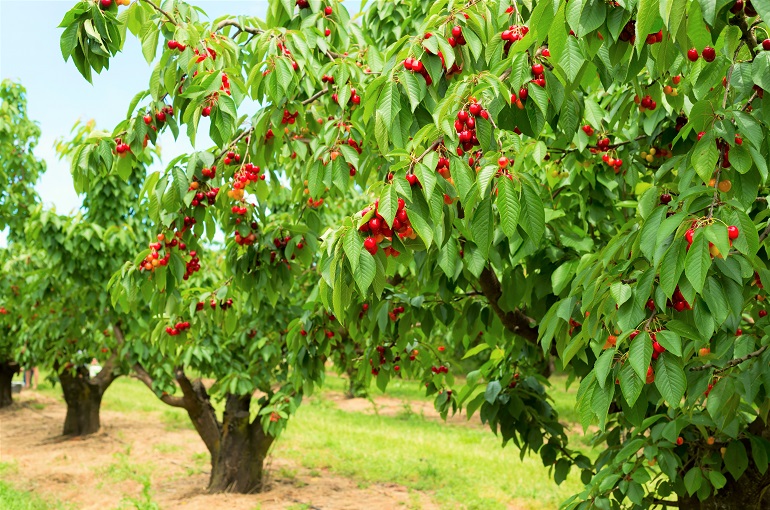Cherries Plant Information

This post is also available in:
This post is also available in:
![]() Español (Spanish)
Español (Spanish) ![]() Français (French)
Français (French) ![]() Deutsch (German)
Deutsch (German) ![]() Nederlands (Dutch)
Nederlands (Dutch) ![]() हिन्दी (Hindi)
हिन्दी (Hindi) ![]() العربية (Arabic)
العربية (Arabic) ![]() Türkçe (Turkish)
Türkçe (Turkish) ![]() 简体中文 (Chinese (Simplified))
简体中文 (Chinese (Simplified)) ![]() Ελληνικά (Greek)
Ελληνικά (Greek) ![]() Português (Portuguese (Brazil))
Português (Portuguese (Brazil))
Botanical characteristics and varieties of cherry trees
Cherry trees are deciduous plants that produce a fleshy drupe (stone fruit) and belong to the Prunus genus of the Rosaceae family. While there are many different cherry species and cultivars, the sweet or true cherries (Prunus avium) and sour (Prunus cerasus) cherries have the highest commercial value. Depending on the species and the variety, a cherry tree can become 4-15 m (13.1-50 feet) tall (sour cherries are generally shorter), but there are some dwarf varieties as well. They usually start producing fruits 3 to 5 years after planting and can survive for over 60 years, but the production usually decreases significantly after 40-50 years. Cherry trees have alternating simple oval leaves, pink-reddish buds, and white flowers (with five petals) that appear in clusters during early spring. The fruit (cherry) is round or heart-shaped and of red, yellow or black color.
Depending on the local environment and soil conditions, a farmer can choose among a variety of cherry cultivars. For example, in warmer climates, it is essential to select varieties with low chilling requirements (less than 300 hours of low temperatures) in order to have a good yield. Minnie Royal, Royal Lee, Royal Crimson, Lapins, and Stella are such varieties. On the other hand, if the field where we want to establish our cherry orchard is in colder areas or prone to frost, the grower can choose among some cold-hardy varieties like Juliet, Nanking, Romeo, Canada Red Select, Early Richmond, English Morello, or Montmorency. Keep in mind that sweet cherry varieties bloom earlier and are a bit less cold-hardy compared to the sour cherries. For successful pollination-fertilization and fruit formation, most cherry trees need cross-pollination, and the farmer should add a good-compatible pollinator variety inside the orchard. Only a few cultivars are self-pollinated, like Stella, Van, Rainier, and Bing. At this point, it is important to mention that most commercially available cherry trees are grafted. As a result, the grower must consider the characteristics of both the rootstock and the grafted variety.
Climate requirements for cherries
Both sweet and sour cherry species originated (indigenous) in the cold climates of western Asia and Europe and can successfully grow in USDA hardiness zones 4 to 7. More specifically, the sweet cherries are most adapted to the environmental conditions of 5-8 zones, while the sour cherry varieties are more cold-hardy and can grow in cooler climates (zones 4-5). In any environment, it is essential that the minimum chilling hours (chilling requirements) required for dormancy break must be satisfied. Otherwise, the trees will have uneven shoot development, (later) flowering and fruit maturity, or even produce limited or no yield. Most cherries require around 500-700 hours of winter chill. The optimum temperature is around 6 °C (42.8 °F), while temperatures above 14 °C (57.2 °F) during the chilling period can negate previously accumulated chill. When the chilling requirements have been satisfied, the flower buds are ready to grow when the temperature rises in spring. The honeybee foraging (for cross-pollination) is maximized when the temperature is around 18 °C (65 °F). Areas with spring and summer temperatures above 32-33 °C (89.6-91.4 °F) should be avoided. On the other hand, despite its relatively cold hardiness, when dormant, cherry trees may withstand temperatures as low as -34 °C (-30 °F) for a very short period of time (depending on the variety). However, temperatures below 0 to -3 °C (32-27 °F) for a prolonged period during blooming can damage up to 90% of the flowers. In comparison, if the temperature drops below -18 °C (-0.4 °F), the damage expands to the stems, branches, and trunks.
References
- https://www.agric.wa.gov.au/climate-change/winter-chill-apples-pears-and-cherries-changing-climate?nopaging=1
- https://www.cherrygrowers.org.au/assets/170614_Chill_Chapter_Production_Manual_Final.pdf
- https://www.washingtonpost.com
- https://www.nps.gov/nama/learn/
- https://plants.ces.ncsu.edu/plants/prunus-avium/
- https://plantvillage.psu.edu/topics/cherry-including-sour/infos
- https://www.ncbi.nlm.nih.gov/pmc/articles/PMC8376227/
- https://www.nutritionvalue.org/Cherries%2C_raw_63115010_nutritional_value.html
Cherries: Info, Facts, Nutritional Value & Health Benefits
Plant Information of cherries
10 Interesting Things About Cherries You Probably Didn’t Know
Growing Cherry Trees for Profit
Soil requirements, preparation, and planting of cherry trees
Cherry Tree Water Requirements
Cherry Tree Propagation and Pollination
Cherry Tree Training, Pruning, and Fruit Thinning
Cherry Tree Fertilization
Cherry Tree Pests and Diseases
Cherries Harvesting and Yield per Hectare – Do you pick cherries with the stem on or off?









































































